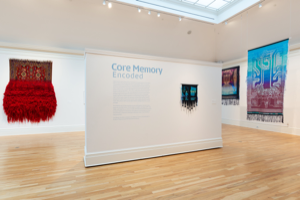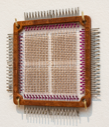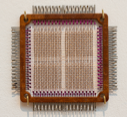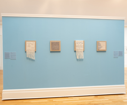Core Memory: Encoded
CompletedFeb 19, 2022 – Jun 25, 2022
Core Memory is presented as two exhibitions in visual dialog, exploring how information is remembered and how the handmade labor of weaving is a foundation for understanding analog and digital logic. All of these artists deploy geometry and numerical systems of pattern in the process of creative expression.
Gathering the work of four artists, Core Memory: Encoded explores the emergent field of systems-based textiles and marks a contemporary shift in art towards computational process and fiber arts. Faig Ahmed, Robin Kang, Beryl Korot and Ahree Lee use handloom weaving as a compositional framework imbued with history and precision. In works that range from painterly tapestries to sculpture, and from video to embroidery—these artists reflect on the cultural impact of modern communications on craft, and emphasize the role of the human body in building images and symbols. For Ahmed, Kang, Korot and Lee, handcrafted textiles represent a critical technology and a fundamental writing system upon which machine logic is based. The interlaced surfaces of the works on view are encoded with patterns that connect women’s labor, engineering and the natural world. These pieces, held in tension with tradition, reimagine the grid as a space of insight.
The exhibition also includes examples of core memory panels manufactured by hand in the mid-20th century. The first digital computers, developed at MIT in the 1940s, used magnetic core memory to read, write and store processed information in a binary language of zeros and ones. The pathway of communication for these early electronic components relied upon handwoven metal wiring and tedious manual assembly.
Core Memory draws from the creative legacy of the H. Sophie Newcomb Memorial College and its prescient synthesis of art, craft, and design to understand weaving technologies. Featuring the work of more than forty artists, Core Memory puts into conversation two modalities of weaving: Indigenous basketry and the emergent field of systems-based textiles. The exhibit explores disparate approaches toward media, tradition and composition – and investigates the animating forces within each artist’s creative practice.
Encoded, organized by Newcomb Art Museum Curator Laura Blereau, highlights a contemporary shift in art toward weaving and fiber arts, as well as computational processes – two production modes with deep connections to grids and women practitioners. Ahree Lee’s algorithmic approach to textiles recalls Ada Lovelace, the 19th century mathematician. Threaded works by video art pioneer Beryl Korot contemplate the impact of technology and language on human behavior and cultural change. Faig Ahmed’s sculptures are produced with weavers from his native Azerbaijan, where carpets have been handwoven since the Bronze Age. Robin Kang uses a digital Jacquard loom to craft tapestries that combine mystical energy and symbolism with computer glitch.
The Core Memory exhibitions, Louisiana Native American Basketry and Encoded, put into conversation two modalities of weaving: Indigenous basketry and the emergent field of systems-based textiles.
For more information, please visit the Encoded website






























